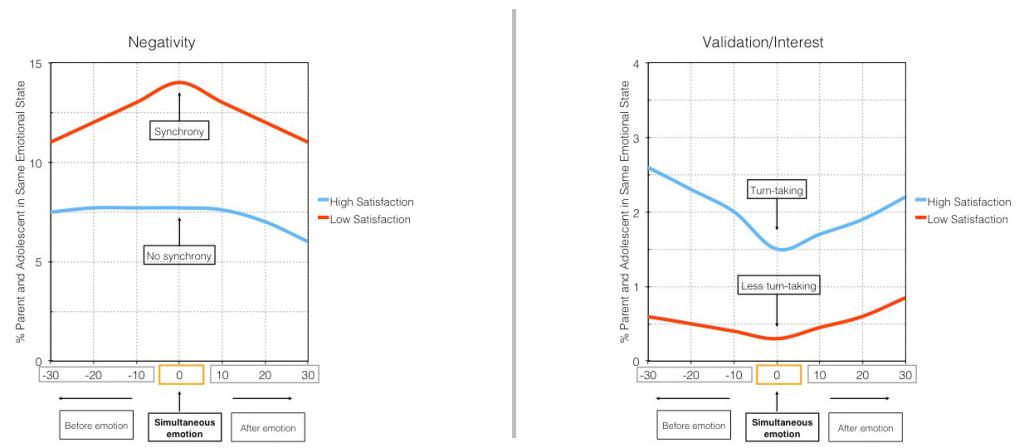Adolescence is a time period when a children’s relationships with their parents can undergo transformations that increase conflict and negative emotion (Laursen & Collins, 2009). To better understand how these conflicts are managed, my colleagues and I analyzed the emotion dynamics—i.e., the patterns of emotional exchange between parents and adolescents—during conflict discussions.
A variety of techniques exist for empirically investigating emotion dynamics in interpersonal relationships, including state space grids, cross-correlation, sequential analyses, and event history analysis (see Butler, 2011)—but our research group used a statistical technique relatively new to the social sciences, recurrence quantification analysis (RQA; Webber & Zbilut, 2005).
RQA allowed us to quantify the timing of the relative occurrence of different types of emotions displayed by mothers and adolescents during an interaction in the lab. Its advantage over other dynamic techniques (like sequential analysis and cross-correlation) is that it can reveal nonlinear patterns—and that it can be easier to interpret (Dale, Warlaumont, & Richardson, 2011).
In our study, 50 mother-adolescent dyads discussed a topic of frequent conflict for 10 minutes. Emotions were coded second by second using the Specific Affect Coding System (SPAFF; Coan & Gottman, 2007), resulting in simultaneous time series of 16 different verbal and nonverbal codes.
Using RQA combined with growth curve analyses, we found that mothers and adolescents tended to display negative (e.g., contempt, anger, defensiveness) and positive (e.g., humor, enthusiasm) emotions simultaneously, while they tended to exhibit a turn-taking pattern in validation and interest (i.e., conveying understanding and curiosity about the other person’s point of view). This suggests that patterns of emotion synchrony between individuals vary across emotion types, with some emotions tending to be displayed simultaneously, while others exhibit more of a turn-taking structure during social interaction.
Further analyses revealed that dyads that were particularly dissatisfied with the process and outcome of the conflict discussion were particularly likely to display negative emotions concurrently, suggesting a pattern of mutual negativity. Conversely, better conflict resolution was achieved when mothers and adolescents took turns validating and showing interest – but only if these responses were reciprocated within 30 seconds.
Despite the tendency in the field to focus on the influence of parental behaviors on children, this study suggests that it is not just parental validation or interest that is important during conflict, but that both parents and adolescents are given a chance to speak their minds and feel “heard” by the other person.
There were differences across adolescent ages as well. In dyads with younger adolescents (ages 13-14), mothers were typically the first to introduce negativity into the conversations; with older adolescents (ages 17-18), the adolescents were more likely to display negative emotions first. This is consistent with prior research demonstrating that parent-child relationships become more horizontal and egalitarian over the course of adolescence (Goede, Branje, & Meeus, 2009).
Our ongoing research focuses on other dynamic patterns of emotion exchange in parent-adolescent interactions (e.g., attractor strength of emotion sequences). Furthermore, new studies are underway examining emotion dynamics in underrepresented populations who might be at particular risk for poor conflict resolution, including chronic illness populations, teen parents, and ethnic minority families of high socioeconomic risk.
Using novel statistical techniques such as RQA to analyze interpersonal interactions adds to our understanding of parent-child relationships and may allow us to target more specific interventions for parents and adolescents struggling with conflict.

References:
Handbook of adolescent psychology, Vol 2: Contextual influences on adolescent development (3rd ed.), (pp. 3-42). Hoboken, NJ: John Wiley & Sons.
Butler, E. A. (2011). Temporal interpersonal emotion systems: The “TIES” that form relationships. Personality and Social Psychology Review, 15, 367-393.
Webber Jr., C., & Zbilut, J. (2005). Recurrence quantification analysis of nonlinear dynamical systems. In M. A. Riley & G. C. Van Orden (Eds.), Tutorials in Contemporary Nonlinear Methods for the Behavioral Sciences (pp. 26–94). Arlington, VA: Digital Publication Available through the National Science Foundation. Retrieved from http://www.nsf.gov/sbe/bcs/pac/nmbs/nmbs.jsp
Dale, R., Warlaumont, A. S., & Richardson, D. C. (2011). Nominal cross recurrence as a generalized lag sequential analysis for behavioral streams. International Journal of Bifurcation and Chaos, 21, 1153-1161.
Coan, J. A., & Gottman, J. M. (2007). The Specific Affect Coding System (SPAFF). Series in affective science. In J. A. Coan & J. A. Allen (Eds.), Handbook of emotion elicitation and assessment (pp. 267-285). New York, NY, US: Oxford University Press.
Goede, I. H. A., Branje, S. J. T., & Meeus, W. H. J. (2009). Developmental changes in adolescents’ perceptions of relationships with their parents. Journal of Youth and Adolescence, 38, 75-88.



